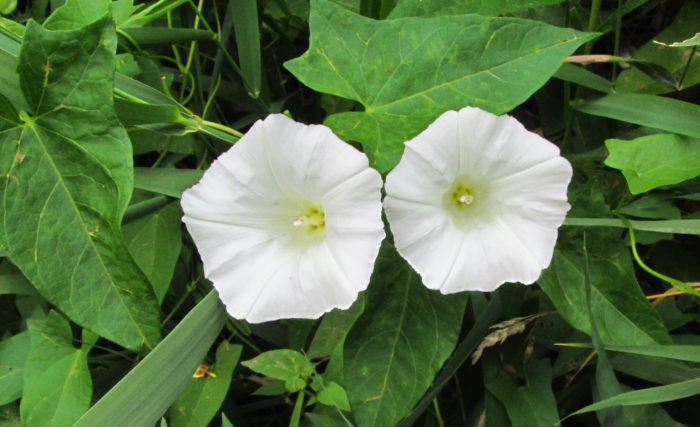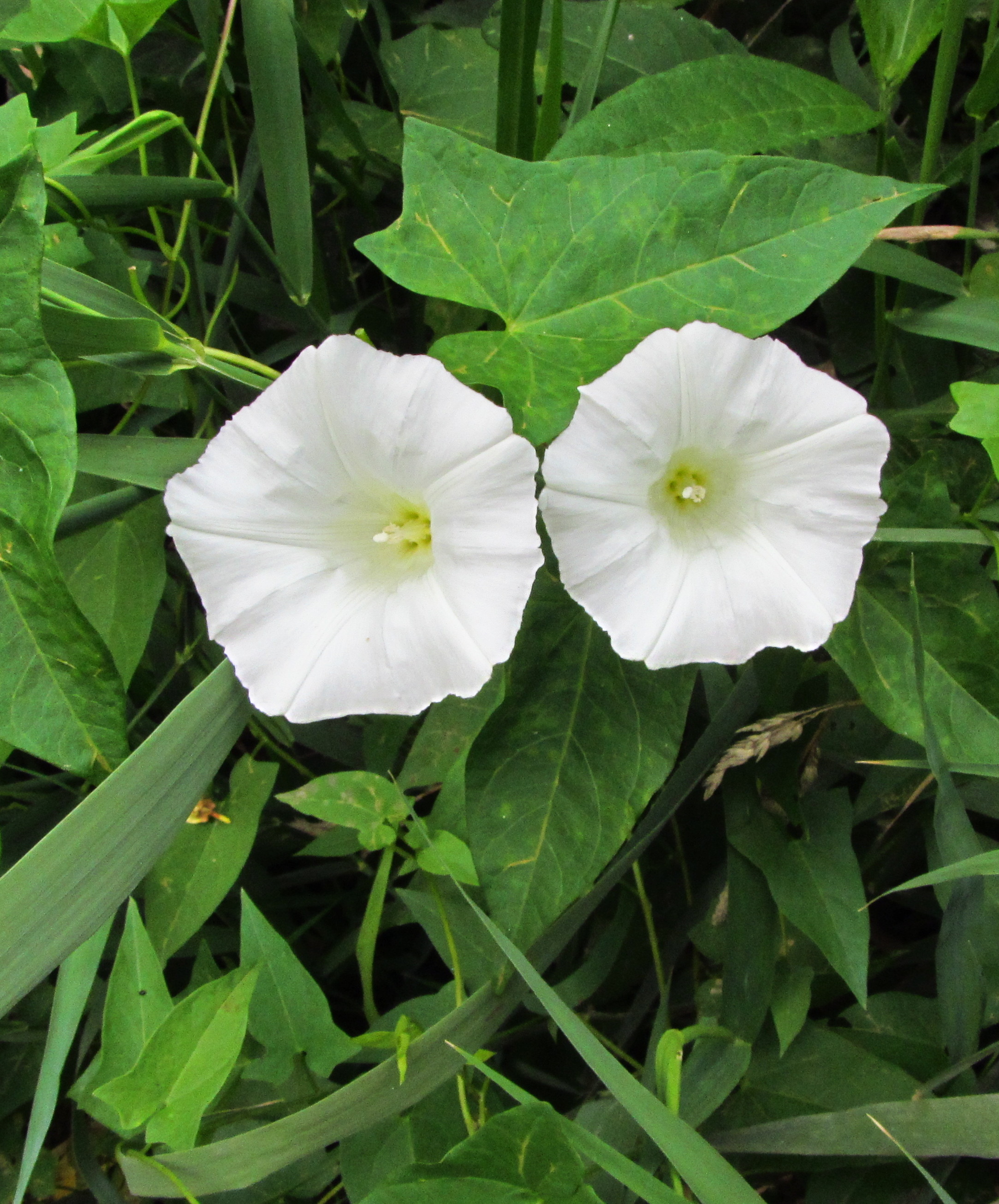UPDATE/CORRECTION: Bleeding Heartland user PrairieFan speculated that I photographed the native vine Hedge bindweed, (Convolvulus sepium or Calystegia sepium). John Pearson of the Iowa Department of Natural Resources confirms: “The key character between the two species is the size of the bracts at the base of the flower: small in C. arvensis versus large (leaf-like) in C. sepium. The photos in your article that provide a profile view of the flowers show large, leaf-like bracts that would point to C. sepium.” Hedge bindweed is also found across North America. Original post follows:
I haven’t featured many vines in this series, other than bittersweet nightshade, bur cucumber, and wild grape. I’ve also rarely focused on non-native plants, with exceptions noted in the archive. So this week is doubly unusual.
Field bindweed (Convolvulus arvensis) originated in Eurasia but has spread to nearly every part of the U.S. and Canada. Don’t go looking for this plant in high-quality habitats; according to the Illinois Wildflowers site, field bindweed “occurs primarily in disturbed areas” such as “lawns, gardens, fields, clay banks, areas along roadsides and railroads (including ballast), vacant lots, and miscellaneous waste areas.” You probably won’t want to cultivate it, but it may find its way onto your property.
It has considerable drought tolerance, and flourishes in poor soil that contains sand, gravel, or hardpan clay. […] Eradication of this plant is difficult, as mechanical cultivation often spreads the rhizomes around, producing new plants. Because of the deep root system, it has been known to survive bulldozer operations. It can also persist in lawns, notwithstanding regular lawn-mowing. The application of broadleaf herbicides can be an effective control measure, if it is repeated as needed.
I took all of the pictures enclosed below last month along the Windsor Heights or Walnut Creek bike trails.
Field bindweed vines can start blooming in the late spring and keep producing flowers for months, “even though individual flowers persist for only a single day, usually opening during the morning and closing by late afternoon.” The arrow-shaped leaves of field bindweed somewhat resemble arrowhead, but you can’t confuse these species once the plants are blooming. Arrowhead flowers with white petals and yellow or green centers look nothing like field bindweed blossoms.
I’ve mostly seen white flowers, but some vines produce flowers tinged with pink.
Side view of two flowers. The leaves in the center with toothed edges are not part of the bindweed; I think that’s a wild grape vine.
On the left, a bud hasn’t opened yet.
Hedge bindweed growing near the bank of Walnut Creek:
Hedge bindweed vines often become intertwined with other plants. The plant with pale yellow flowers is common evening primrose.
The yellow flowers here are wingstem.












4 Comments
Good news:-)!
Those lovely large white flowers you photographed are those of an Iowa native. It is not a universally-beloved native wildflower, and some people go to a lot of trouble to get rid of it. And it can get carried away and spread a lot in some situations. But some of us really like it, and it has as much right to be in a natural area as any other “weedy native.” I’m grateful for its determination, because it persists and blooms in some places where few other native wildflowers do.
I know this flower as hedge bindweed, Convolvulus sepium. But it has other species names and apparently it’s also called Calystegia sepium and I’m not sure which name is the current standard. It’s found along field borders, woodland edges, and roadsides, but I’ve seen it on prairie edges too — it likes a little disturbance. Some native bees like it, and I see the foliage being eaten by pretty little beetles.
Field bindweed, Convolvulus arvensis, is indeed non-native. I see it growing mostly on the edges of gravel roads. The leaves and flowers are noticeably smaller than those of hedge bindweed. There’s another native bindweed in Iowa called low bindweed, but apparently it’s found only in eastern Iowa and I’ve never seen it.
PrairieFan Thu 13 Sep 1:12 AM
thanks for the news!
I will update the post.
desmoinesdem Thu 13 Sep 11:15 AM
John Pearson of the DNR
confirms your ID: “The key character between the two species is the size of the bracts at the base of the flower: small in C. arvensis versus large (leaf-like) in C. sepium. The photos in your article that provide a profile view of the flowers show large, leaf-like bracts that would point to C. sepium.”
desmoinesdem Thu 13 Sep 2:20 PM
I appreciate that info
Thanks for posting that tip. I didn’t know that — I was going by the shapes of the leaves, which are different in the two species, and also by size and general botanical gestalt. That is one difference between an amateur like me and a professional like John Pearson.
As an aside, back in the late Eighties, a moth was brought over from Europe
and released in the U.S. to help reduce the amount of C. arvensis out west, where it is a serious crop problem. But back then, a lot of biocontrols were barely or badly tested. Sure enough, the moth also feeds on the native hedge bindweed. Three decades is still too early to know if problems might result in the long run. We’ve learned the hard way that some non-natives take several decades to show what they can really do.
Biocontrols can have great value. But they need to be thoroughly tested, because some biocontrols that target non-native problem plants can also target their benign native relatives. One example is an imported thistle insect that is now reducing populations of rare native thistles that never caused problems and are on endangered species lists.
PrairieFan Thu 13 Sep 6:10 PM